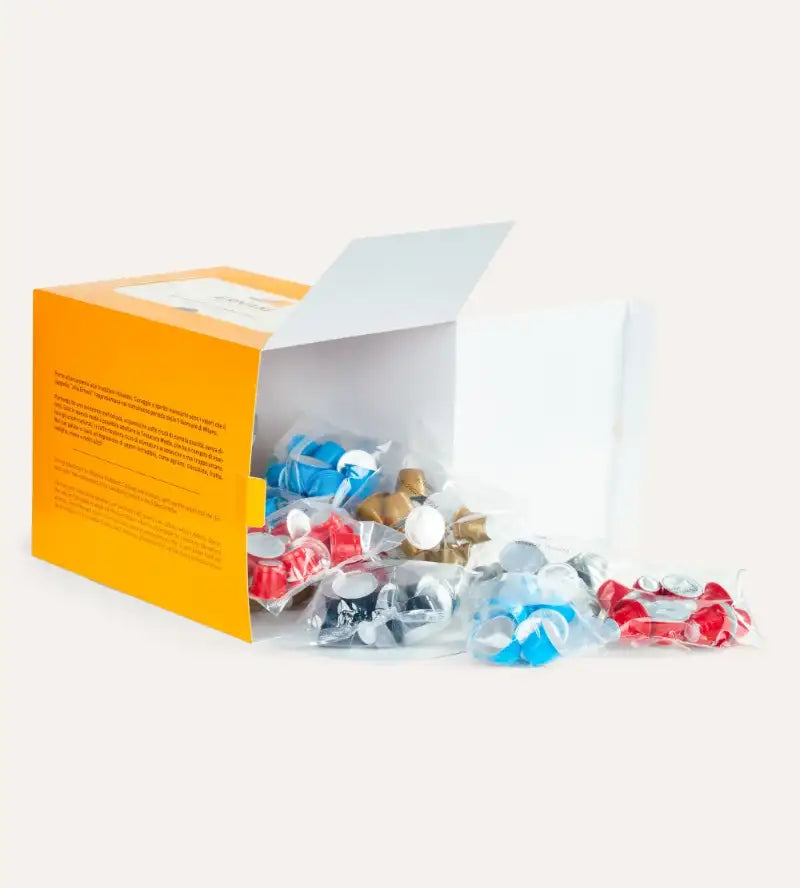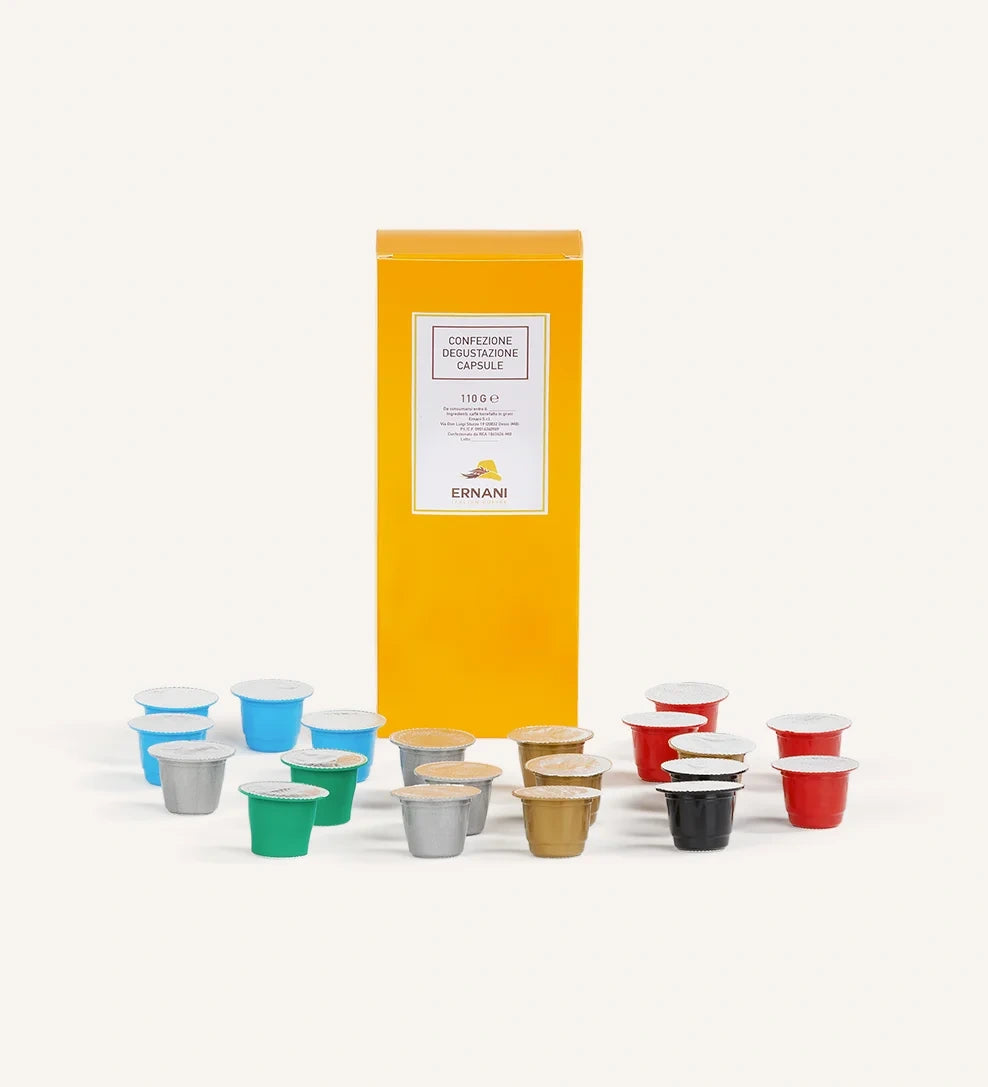
Allegro - 20 / 200 capsules
Save up to 10% by choosing periodic delivery
Description
A blend with a higher percentage of Arabica coffee, with sweet notes of chocolate and hazelnuts, and a round body.
70% Arabica and 30% Robusta:
- Colombia Finca la Meseta, washed arabica
- Brazil Bom chocolate, natural arabica
- India Kalledevarapura, semi-washed arabica
- Tanzania Superior, natural robusta
- Congo Mombasa, natural robusta
- Ivory Coast, natural robusta
Allegro is the flagship blend of the Torrefazione at Corso Buenos Aires 20 in Milan, served at the counter for several decades now, which releases, at times, the fresh and sweet aromas of the single-origin Arabica beans, combined with the body and intensity of the Robusta.
- On the nose the aroma is intense and features notes of cocoa and nuts.
- On the palate, a delicate acidity is immediately noticeable, with notes of citrus, which quickly fades in favor of the sweetness of red fruits and hazelnuts, balanced by a pleasant bitterness, which brings with it a hint of cocoa, very persistent over time.
Suitable for
Those looking for an aromatic blend, with a delicate acidity, creamy and round body
Technical data sheet
- Aromatic notes: cocoa, hazelnuts and citrus fruits
- Intensity: 7/10
- Body: 5.5/9
- Sweetness: 3.5/9
- Bitterness: 3.5/9
- Acidity: 6/9
- Aromatic intensity: 6.5/9
- Roasting: medium
- Composition: 70% Arabica – 30% Robusta
- Origins: Colombia Finca la Meseta washed arabica, India Kalledevarapura semi-washed arabica, Brazil Bom Chocolate natural arabica, Tanzania Superior natural robusta, Congo Mombasa natural robusta
Thanks to the medium roast, the carefully selected raw coffee beans can express themselves to their fullest, releasing all their natural aromas without ever being overly bitter. Try it without sugar, it's incredible!
Each individual capsule is self-protected in a controlled atmosphere of food-grade nitrogen. This eliminates the need for additional secondary packaging to wrap each capsule, creating unnecessary waste. Furthermore, the coffee is protected from oxygen-induced oxidation, thus maintaining its aromatic complexity and flavor even after several months.
Notes for the 20 capsule pack:
- 20 capsules compatible with Nespresso home machines (a brand owned by Societe de Products Nestlé SA)
- Packaged in a protective nitrogen atmosphere
- 110 g net weight
- Roasted coffee beans
Notes for the 200 capsule pack:
- 200 capsules compatible with Nespresso home machines (a brand owned by Societe de Products Nestlé SA)
- Packaged in a protective nitrogen atmosphere
- 1100 g net weight
- Roasted coffee beans
History of coffee
Today we travel to five different countries with our Allegro blend: Colombia, India, Brazil, Tanzania and Congo.
You've already tasted single-origin coffees, now try them as a blend and discover how they enhance each other, creating a unique and complex flavor.
Colombia
Let's start with Colombia, one of the most evocative coffee-growing regions in the world, so much so that its landscapes are a UNESCO World Heritage Site.
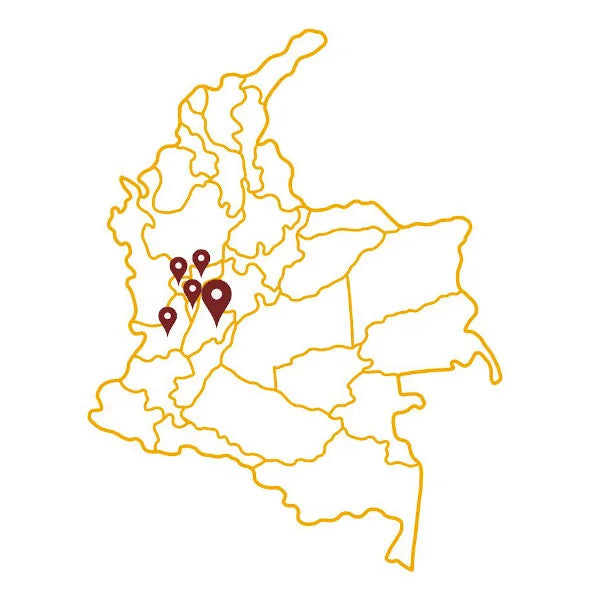
The Eje Cafetero is a rural area that extends across several departments toward the south of the state, beyond Medellin. The best known are Caldas, Quindio, Risaralda, Tolima, and Valle del Cauca.
Here, life flows slowly, in contact with and respect for nature, made of simplicity and centuries-old cultural traditions.
Coffee has influenced the economy, lifestyle, traditions, habits and customs of the small historic villages of coffee growers, who pass down knowledge and skills from father to son.
When I drink a cup of Colombia Supremo Finca la Meseta, I imagine myself among the beautiful thermal areas, immersed in vast plantations of an intense emerald green, embraced by cloud forests, among steep valleys and glaciated peaks, kissed by the sun and overlooking the National Parks of the Andes.
Here is the hacienda from which we buy our Colombian coffee, from the Finca called La Meseta.
A region dotted with Andean forest, with a climate ranging from 8° to 24° Celsius, altitudes between 1,100 and 2,000 meters, and constant rainfall year-round. All this makes the land perfect for growing a top-quality coffee.
And to honor their product, the recognedores, or pickers of the red berries, always work by hand, making a careful selection and picking only the perfectly ripe cherries.
The flavor is smooth, fresh, fruity, floral, and almondy. Sniff a cup of Blue Diamond and you'll sense this intense almond note!
Find out more about this coffee by clicking here.
India
We move on to India, among the Baba Budan Giri hills, below the Tropic of Cancer, which constitute the main region for the production and consumption of the dark drink.
In particular, with our Kalledevarapura, we are located in the region of Karnataka and Tamil Nadu.
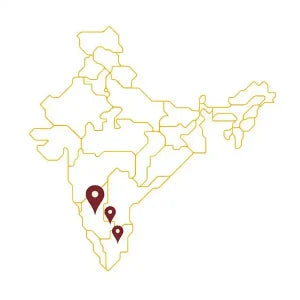
These regions are cool year-round and enjoy abundant rainfall. The soil is deep and fertile. Furthermore, this area is characterized by the presence of tall trees, which allow coffee plants to be grown in the shade, protecting them from the strong, hot direct sun.
These conditions create fertile ground for growing great coffee!
The same plantations grow not only coffee, but also pepper, cardamom, cinnamon, cloves, nutmeg, and 45 other plant species. This botanical diversity gives the beans a wide aromatic variety and intense flavor.
In short, I imagine a trip to the Indian plantations with my nose in the air, ready to capture all the imaginative aromatic nuances and the intoxicating scent of flowers, fruits, and spices.
Overall, Indian Arabica coffees have good acidity and creaminess, rich in aromas: from tea leaves to chocolate, from ripe fruit pulp to red berries, from chocolate to honey, and from nuts to spices and tobacco. In short, a triumph of flavor.
Find out more about this coffee by clicking here.
Brazil
We return to America, landing in Brazil, the number one country in terms of quantity of coffee produced and sold in the world, and therefore also one of the most consumed and well-known coffees!
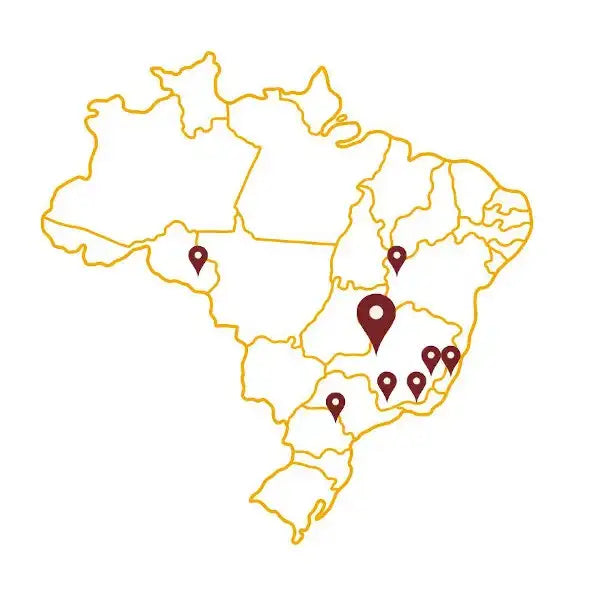
Brazil boasts a multitude of coffee farms, both sprawling, industrially farmed coffee farms that produce low-quality coffee, and micro-farms specializing in specialty coffee. In short, the coffee-growing region is vast and diverse.
The two departments known for producing quality coffee are the Cerrado region, where our Bom Chocolate comes from, and the Minas Gerais region slightly southeast of the former.
The Cerrado region obtained the IP (Indication of Provenance) mark in 2005 and the DO, thus also recognized with the Denomination of Origin mark, in 2014. This region is characterized by the quality of its raw beans and its unique climatic conditions. Furthermore, the coffee plants have intense flowering, with uniform ripening of a concentrated crop, combined with perfectly defined climatic seasons, with hot, humid summers and mild, dry winters.
A set of perfectly synchronized variables that create unique and ideal conditions for our beloved plant with bright red fruits.
Authentic Cerrado Mineiro coffee has intense aromas, a caramel flavor and hints of dried fruit, with a delicate citrus acidity and a predominantly chocolatey flavor that is very persistent.
I imagine Brazil as vast, made up of hills and plateaus between 900 and 1600 meters above sea level. Greenery and fields as far as the eye can see, with a clear sky contrasting with the land.
Find out more about this coffee by clicking here.
Africa
We conclude our journey in Africa, the cradle of human civilization, birthplace of the coffee plant, the only land that seems to tell us the beginning of every story.
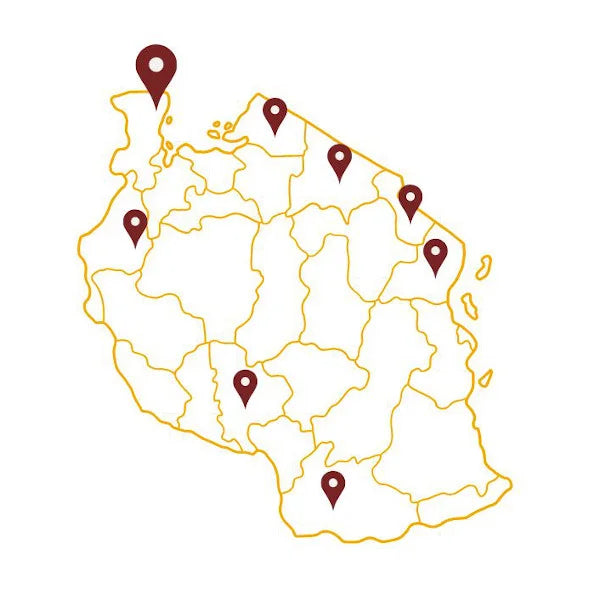
The first natural robusta comes from Tanzania and is a Superior, from the Bukoba region, grown above 800 metres above sea level.
Tanzania is a country I'm very fond of and have had the pleasure of visiting both along the coast and inland. Among giraffes, lions, and other savannah animals, it reveals some of the wonders of the world, rich in contrasting colors: the red earth, the savannah with its green trees, and a clear blue sky.
People also always have colorful clothes and a beautiful smile on their faces.
The coffee-growing area of Kagera and Bukoba, in the north-east of the country on the shores of Lake Victoria, is home to mainly natural Robusta beans with an intense aroma and a chocolatey flavour.
The second natural robusta comes from Congo, from the Mombasa area, in the north-east of the state, grown above 600 metres above sea level.
Beans from the Congo often have a rich flavor and high caffeine levels. This gives them a greater bitterness and a truly intense roundness and body.
The coffee-growing region known as the Great North, perhaps one of the most productive areas in the country, produces both excellent Arabica and high-quality Robusta coffees. It offers full-bodied, intense, creamy coffees with aromatic notes that bring to life the flavor of the plant: light woody notes, flowers, and roasted cocoa.
So, with a taste of our Allegro you will find yourself first in Colombia, with the more delicate notes of red fruits and almonds.
Immediately after, the aromatic complexity of Indian spices arrives, along with a hint of tobacco. And finally, Brazil, with toasted notes like caramel and chocolate.
In the aftertaste, however, you will travel to Africa with persistent aromatic notes of bitter cocoa that characterize the selected Robusta.
This blend is excellent in moka pots, espresso pots and capsules.
Find out how to best prepare it with all the tools here.
Have a good trip!
You might be interested in




